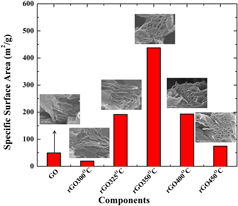Crossref Citations
This article has been cited by the following publications. This list is generated based on data provided by
Crossref.
Sengupta, Iman
Bhattacharya, Proma
Talukdar, Monikangkana
Neogi, Sudarsan
Pal, Surjya K.
and
Chakraborty, Sudipto
2019.
Bactericidal effect of graphene oxide and reduced graphene oxide: Influence of shape of bacteria.
Colloid and Interface Science Communications,
Vol. 28,
Issue. ,
p.
60.
Narayanan, Kannan Badri
Choi, Soon Mo
and
Han, Sung Soo
2019.
Biofabrication of Lysinibacillus sphaericus-reduced graphene oxide in three-dimensional polyacrylamide/carbon nanocomposite hydrogels for skin tissue engineering.
Colloids and Surfaces B: Biointerfaces,
Vol. 181,
Issue. ,
p.
539.
Zhu, Tianyu
Wang, Yan
Li, Yang
Cai, Rui
Zhang, Jianfang
Yu, Cuiping
Wu, Jingjie
Cui, Jiewu
Zhang, Yong
Ajayan, Pulickel M.
and
Wu, Yucheng
2020.
CoO Quantum Dots Anchored on Reduced Graphene Oxide Aerogels for Lithium-Ion Storage.
ACS Applied Nano Materials,
Vol. 3,
Issue. 10,
p.
10369.
OKUTAN, Merve
2020.
Termal indirgenmiş grafen oksit ile elektrokimyasal olarak askorbik asit tayini.
Gazi Üniversitesi Mühendislik Mimarlık Fakültesi Dergisi,
Vol. 35,
Issue. 3,
p.
1589.
Santos, Patrícia F.
Ribeiro, Josimar
and
Luz, Priscilla P.
2020.
Physicochemical and electrochemical characterization of Ce/carbonaceous matrices-based composites.
Solid State Sciences,
Vol. 110,
Issue. ,
p.
106479.
Narayanan, Kannan Badri
Kim, Hyun Duck
and
Han, Sung Soo
2020.
Biocompatibility and hemocompatibility of hydrothermally derived reduced graphene oxide using soluble starch as a reducing agent.
Colloids and Surfaces B: Biointerfaces,
Vol. 185,
Issue. ,
p.
110579.
Raza, A.
Qumar, U.
Hassan, J.
Ikram, M.
Ul-Hamid, A.
Haider, J.
Imran, M.
and
Ali, S.
2020.
A comparative study of dirac 2D materials, TMDCs and 2D insulators with regard to their structures and photocatalytic/sonophotocatalytic behavior.
Applied Nanoscience,
Vol. 10,
Issue. 10,
p.
3875.
Shen, Yue
Zhang, Shengdi
Sun, Yanxia
Hai, Chunxi
Li, Xiang
Zeng, Jinbo
Ren, Xiufeng
and
Zhou, Yuan
2020.
Structure and Property Evolution of Graphene Oxide Sheets during Low-Temperature Reduction on a Solid Substrate.
The Journal of Physical Chemistry C,
Vol. 124,
Issue. 26,
p.
14371.
Silipigni, L.
Salvato, G.
Fazio, B.
Di Marco, G.
Proverbio, E.
Cutroneo, M.
Torrisi, A.
and
Torrisi, L.
2020.
Temperature and environment effects on the graphene oxide reduction via electrical conductivity studies.
Journal of Materials Science: Materials in Electronics,
Vol. 31,
Issue. 14,
p.
11847.
Henriques, Patrícia C.
Pereira, Andreia T.
Pires, Ana L.
Pereira, André M.
Magalhães, Fernão D.
and
Gonçalves, Inês C.
2020.
Graphene Surfaces Interaction with Proteins, Bacteria, Mammalian Cells, and Blood Constituents: The Impact of Graphene Platelet Oxidation and Thickness.
ACS Applied Materials & Interfaces,
Vol. 12,
Issue. 18,
p.
21020.
Pratama, Buky Wahyu
and
Dwandaru, Wipsar Sunu Brams
2020.
Synthesis of reduced graphene oxide based on thermally modified liquid-phase exfoliation.
Nano Express,
Vol. 1,
Issue. 1,
p.
010023.
Singh, Sohan Bir
and
De, Mahuya
2020.
Thermally exfoliated graphene oxide for hydrogen storage.
Materials Chemistry and Physics,
Vol. 239,
Issue. ,
p.
122102.
Cutroneo, M.
Havranek, V.
Mackova, A.
Malinsky, P.
Torrisi, A.
Silipigni, L.
Sofer, Z.
and
Torrisi, L.
2020.
Selective modification of electrical insulator material by ion micro beam for the fabrication of circuit elements.
Radiation Effects and Defects in Solids,
Vol. 175,
Issue. 3-4,
p.
307.
Sengupta, Iman
Sharat Kumar, Suddhapalli S.S.
Pal, Surjya K.
and
Chakraborty, Sudipto
2020.
Characterization of structural transformation of graphene oxide to reduced graphene oxide during thermal annealing.
Journal of Materials Research,
Vol. 35,
Issue. 9,
p.
1197.
Silva, Mariana R.F.
Lourenço, Mirtha A.O.
Tobaldi, David Maria
da Silva, Carla F.
Seabra, Maria Paula
and
Ferreira, Paula
2020.
Carbon-modified titanium oxide materials for photocatalytic water and air decontamination.
Chemical Engineering Journal,
Vol. 387,
Issue. ,
p.
124099.
Khoramgah, Maryam Sadat
Ranjbari, Javad
Abbaszadeh, Hojjat-Allah
Tabatabaei Mirakabad, Fatemeh Sadat
Hatami, Shadie
Hosseinzadeh, Simzar
and
Ghanbarian, Hossein
2020.
Freeze-dried multiscale porous nanofibrous three dimensional scaffolds for bone regenerations.
BioImpacts,
Vol. 10,
Issue. 2,
p.
73.
Gaffoor, M Z
Jarvis, A L L
Young, E A
and
Dorrell, D
2020.
Comparison of the Effect of Graphene and Graphene Oxide Doping on YBCO.
Journal of Physics: Conference Series,
Vol. 1559,
Issue. 1,
p.
012028.
Altin, Yasin
Yilmaz, Hazal
Unsal, Omer Faruk
and
Bedeloglu, Ayse Celik
2020.
Graphene oxide modified carbon fiber reinforced epoxy composites.
Journal of Polymer Engineering,
Vol. 40,
Issue. 5,
p.
415.
Latorrata, Saverio
Cristiani, Cinzia
Basso Peressut, Andrea
Brambilla, Luigi
Bellotto, Maurizio
Dotelli, Giovanni
Finocchio, Elisabetta
Gallo Stampino, Paola
and
Ramis, Gianguido
2020.
Reduced Graphene Oxide Membranes as Potential Self-Assembling Filter for Wastewater Treatment.
Minerals,
Vol. 11,
Issue. 1,
p.
15.
Ramírez-Amador, R.
Alvarado, J.
Flores-Carrasco, G.
Morales-de la Garza, L.
Alcántara-Iniesta, S.
Luna-Flores, A.
Bernal, Y. P.
Méndez Rojas, Miguel Ángel
Gervacio-Arciniega, J. J.
Martínez Hernández, H. P.
Curioca-Vega, J. F.
and
Balcón-Camacho, J.
2020.
The Influence of Deposition Time on the Structural, Morphological, Optical and Electrical Properties of ZnO-rGO Nanocomposite Thin Films Grown in a Single Step by USP.
Crystals,
Vol. 10,
Issue. 2,
p.
73.





